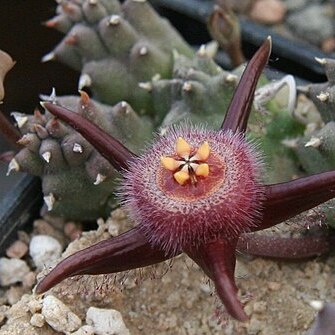Perennial, dwarf succulent. Stems decumbent, spherical to ovoid-cylindrical, 12-30 (-45) x 12-25 mm, glabrous, dark green, 5-or 6-angled with obtuse teeth tipped with 1.0-1.5 mm long leaf rudiment. Flowers 1-4; pedicels 15-25 mm long. Sepals 4-5 mm long. Corolla 30-45 mm in diam.; annulus prominent, circular to ± pentagonal, mottled brownish, 9-15 mm in diam., densely pubescent with whitish to purple hairs; lobes reddish brown to purple or greenish, spreading, 12-16 x 3-5 mm, longitudinally furrowed, replicate but somewhat expanded basally with purple, vibratile, clavate hairs on basal 2/3 and simple hairs in basal sinuses. Corona 6-9 mm in diam.; outer lobes reddish brown to purple, spreading into a ± pentagonal disc; inner lobes 2-3 mm long with apices extended into obtuse, ascending, dorsal lobules.
Perennial herb, 12-45 x 12-25 mm. Stems succulent, clustered; globular, 6-angled; dark green. Leaves rudimentary, ± 1 x 1 mm. Flowers: inflorescence with 1-several flowers near base of stem; 30-45 mm wide, with strong foetid odour; corona reddish brown, pale maroon, dark purple; annulus fleshy, spotted and densely pubescent, hairs white to purple and 2-4 mm long; corolla (25-)30-45 mm wide, lobes with longitudinal furrows, widely but not fully reflexed, margins with purple hairs 2-4 mm long; Feb.-May. Fruit a follicle.

